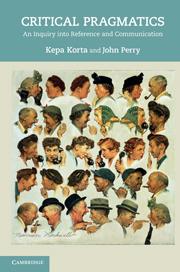Book contents
- Frontmatter
- Contents
- Preface
- Acknowledgments
- 1 Introduction
- 2 A short history of reference
- 3 Acts, roles, and singular reference
- 4 Elements of reference
- 5 Demonstratives
- 6 Context sensitivity and indexicals
- 7 Names
- 8 Definite descriptions
- 9 Implicit reference and unarticulated constituents
- 10 Locutionary content and speech acts
- 11 Reference and implicature
- 12 Semantics, pragmatics, and Critical Pragmatics
- 13 Harnessing information
- 14 Examples
- Bibliography
- Index
4 - Elements of reference
Published online by Cambridge University Press: 05 March 2013
- Frontmatter
- Contents
- Preface
- Acknowledgments
- 1 Introduction
- 2 A short history of reference
- 3 Acts, roles, and singular reference
- 4 Elements of reference
- 5 Demonstratives
- 6 Context sensitivity and indexicals
- 7 Names
- 8 Definite descriptions
- 9 Implicit reference and unarticulated constituents
- 10 Locutionary content and speech acts
- 11 Reference and implicature
- 12 Semantics, pragmatics, and Critical Pragmatics
- 13 Harnessing information
- 14 Examples
- Bibliography
- Index
Summary
Introduction
Most of the theories we surveyed in Chapter 2 give words and their meanings the key role in determining reference. Especially for those in the logical wing of referentialism, the theory of reference is a relatively autonomous discipline, concerned with referring expressions and the conditions of reference they impose. Contextual factors are modelled as set theoretic objects. Utterances may inspire the theory, but do not make an official appearance in it. Intentions come in around the edges, at most, to resolve ambiguity and nambiguity, supplement incomplete descriptions, and the like. The causal theory of reference is seen more as a story of how names come to have the semantics that they do, rather than as a part of that semantics. Philosophers from the language wing, especially Donnellan, see things a bit differently. He gives intentions of the speaker a leading role in determining the reference of referential descriptions, and focusses on utterances, or at least acts of a person saying something about an object.
In our theory, utterances are the focus of inquiry. The linguistic aspects of the utterance do not operate autonomously; rather, intentions play the major part in determining reference, with words and their meanings playing supporting roles. In this chapter we explain what we see as the basic elements of reference. First, in order to help think about intentions, we provide a rather modest account of minds and cognition.
- Type
- Chapter
- Information
- Critical PragmaticsAn Inquiry into Reference and Communication, pp. 37 - 45Publisher: Cambridge University PressPrint publication year: 2011



